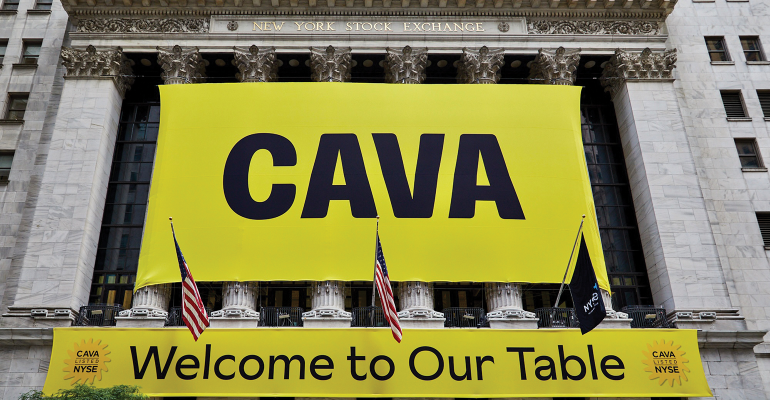The restaurant real estate landscape will remain challenged through 2024 and into 2025, but pockets of development continue apace, according to David Orkin, EVP and restaurant practice leader for real estate services firm CBRE.
“It's going to remain challenged due to supply and demand reasons,” Orkin said. “We haven't had much development in the past half a dozen years, and so we're at an all-time low.”
Shopping center development continues to be hamstrung by limits from the coronavirus pandemic, he added.
“In shopping center development construction,” Orkin said, “costs are up because of the pandemic. Nobody really turned development back on from three or four years ago. But now we're seeing where there is a ton of demand both for retail and restaurants.”
CBRE’s economists anticipate resilient consumer spending will counter economic headwinds in 2024, including high interest rates and near recessions in Europe and China. CBRE predicts the U.S. unemployment rate, which was 3.7% in December, will rise slightly to 4.5%, and an easing of inflation will allow the Federal Reserve to reduce short-term interest rates to around 4.25% by the end of 2024 and to 3.5% in 2025.
“This anticipated economic bottoming out and initial rebound will affect all sectors of commercial real estate,” the company said in December. “CBRE sees lending remaining tight, property values declining further in the first half of the year before activity rebounds in the second half, a topping out of office vacancy, and a wave of multifamily construction.”
“There is a bit more real estate pain ahead, but stabilization and the early stages of recovery aren’t far behind that,” said Richard Barkham, CBRE global chief economist and global head of research, in a statement. “Investment volumes will be down overall for 2024 but will start an upturn in the second half. And leasing activity will pick up a bit from a sluggish 2023.”
U.S. office vacancy will peak at 19.8% in 2024, up from 18.4% in Q3 2023 and 12.1% at the end of 2019. Office-leasing activity will revive slightly in 2024 but remain significantly below pre-pandemic levels, CBRE said. Companies seeking blocks of office space of less than 20,000 square feet will account for the bulk of leasing activity. Office construction will slow to the lowest level since 2014, raising the prospect of a shortage of available Class-A space later in the year.
A long-running lack of new retail construction will contribute to retail availability rates declining by 20 basis points in 2024 to 4.6%. CBRE foresees retail spending moderating to 2.6% in 2024 from 4.4% in 2023, and net absorption — which is new demand for retail space — declining to 28 million square feet from 35 million square feet a year earlier. Luxury retailers will look to expand in U.S. resort markets and underserved major metros like Dallas and Houston, CBRE said.
CBRE works with such restaurant clients such as Darden Restaurants, Bloomin’ Brands, Cooper’s Hawk and others, Orkin said.
“It's a sprint right now,” Orkin said, noting how he works with clients to fill their pipelines two to three years out. “There is a lot of activity, and deals are happening. They’re just taking a little bit longer to do and they're doubles — they're not triples and home runs.”
Restaurants are finding landlords offering less attractive finish-out allowances than before the pandemic, Oritz noted. “They're being reduced, so you have a lot of people competing for fewer sites on less desirable terms. It’s certainly getting more challenging to make deals.”
CAVA, the fast-casual Mediterranean brand with roughly 300 locations, went public in mid-2023. The Washington, D.C.-based company had set on what it called a “coastal smile strategy” for development.
Tricia Tolivar, CAVA’s chief financial officer, said that “coastal smile strategy” involved adding restaurants both on the East and West Coasts as well as the Southeast, based on the CAVA brand’s origins in the District of Columbia, Maryland, and Virginia.
“We took a very unconventional turn and went out to L.A. 3,000 miles across the country and opened locations there,” Tolivar said, crediting CEO Brett Schulman’s expansion strategy. “He really was watching consumer trends even before the pandemic and moving into suburban markets and into the coastal smile. So we think of it down the East Coast across into Texas and up into California.”
The Zoes Kitchen acquisition helped that strategy, she added. “Zoes’ major crown jewels were Atlanta, Dallas and Houston,” she said. “Those were the key markets that were enabling us to fill out that ‘coastal smile’ strategy successfully.”
California remains a difficult real estate market, given legislation in the state, Orkin said.
“If you're there, you're filling out the dance card because you have to,” he said. “You're not pulling up operations and leaving. But if you're not there yet, between the cost of labor, the cost of construction … it's a hard place to develop restaurants. You can have really, really good top-line sales and not make money.”
Contact Ron Ruggless at [email protected]

